Hydrodynamic and Waves Response during Storm Surges on the Southern Brazilian Coast: A Hindcast Study
Abstract
1. Introduction
2. Materials and Methods
2.1. Study Area
2.2. Data Availability
2.3. Modeling Approach
2.4. Hindcast Parameters
2.5. Scenarios Analysis
3. Results and Discussion
3.1. Astronomical Tides
3.2. Wind and Pressure Fields
3.3. Total Water Levels
3.4. Waves
3.5. Local Scale Assessment
4. Conclusions
Supplementary Materials
Author Contributions
Funding
Acknowledgments
Conflicts of Interest
References
- Yin, K.; Xu, S.; Zhao, Q.; Huang, W.; Yang, K.; Guo, M. Effects of land cover change on atmospheric and storm surge modeling during typhoon event. Ocean Eng. 2020, 199, 106971. [Google Scholar] [CrossRef]
- Alexander, K.S.; Ryan, A.; Measham, T.G. Managed retreat of coastal communities: Understanding responses to projected sea level rise. J. Environ. Plan. Manag. 2012, 55, 409–433. [Google Scholar] [CrossRef]
- Staneva, J.; Wahle, K.; Koch, W.; Behrens, A.; Fenoglio-Marc, L.; Stanev, E.V. Coastal flooding: Impact of waves on storm surge during extremes—A case study for the German Bight. Nat. Hazards Earth Syst. Sci. 2016, 16, 2373–2389. [Google Scholar] [CrossRef]
- Marcos, M.; Rohmer, J.; Vousdoukas, M.I.; Mentaschi, L.; Le Cozannet, G.; Amores, A. Increased Extreme Coastal Water Levels Due to the Combined Action of Storm Surges and Wind Waves. Geophys. Res. Lett. 2019, 46, 4356–4364. [Google Scholar] [CrossRef]
- Lopes, C.L.; Dias, J.M. Assessment of flood hazard during extreme sea levels in a tidally dominated lagoon. Nat. Hazards 2015, 77, 1345–1364. [Google Scholar] [CrossRef]
- Lyddon, C.; Brown, J.M.; Leonardi, N.; Plater, A.J. Flood Hazard Assessment for a Hyper-Tidal Estuary as a Function of Tide-Surge-Morphology Interaction. Estuaries Coasts 2018, 41, 1565–1586. [Google Scholar] [CrossRef]
- Batstone, C.; Lawless, M.; Tawn, J.; Horsburgh, K.; Blackman, D.; McMillan, A.; Worth, D.; Laeger, S.; Hunt, T. A UK best-practice approach for extreme sea-level analysis along complex topographic coastlines. Ocean Eng. 2013, 71, 28–39. [Google Scholar] [CrossRef]
- Muler, M.; Bonetti, J. An Integrated Approach to Assess Wave Exposure in Coastal Areas for Vulnerability Analysis. Mar. Geod. 2014, 37, 220–237. [Google Scholar] [CrossRef]
- Ohz, A.; Klein, A.H.F.; Franco, D. A Multiple Linear Regression-Based Approach for Storm Surge Prediction Along South Brazil. In Climate Change, Hazards and Adaptation Options; Springer International Publishing: Cham, Switzerland, 2020; pp. 369–388. ISBN 978-3-030-37424-2. [Google Scholar]
- Rodríguez, M.G.; Nicolodi, J.L.; Gutiérrez, O.Q.; Losada, V.C.; Hermosa, A.E. Brazilian Coastal Processes: Wind, Wave Climate and Sea Level. In Brazilian Beach Systems; Short, A.D., Klein, A.H.d.F., Eds.; Springer International Publishing: Cham, Switzerland, 2016; pp. 37–66. ISBN 978-3-319-30392-5. [Google Scholar]
- CEPED. Relatório dos Danos materiais e Prejuízos Decorrentes de Desastres Naturais em Santa Catarina: 1995–2014; Schadeck, R., Ed.; Centro Universitário de Estudos e Pesquisas sobre Desastres: Florianópolis, Brazil, 2016.
- McTaggart-Cowan, R.; Bosart, L.F.; Davis, C.A.; Atallah, E.H.; Gyakum, J.R.; Emanuel, K.A. Analysis of Hurricane Catarina (2004). Am. Meteorol. Soc. 2006, 134, 3029–3053. [Google Scholar] [CrossRef]
- Marcelino, E.V. Impact of the Catarina cyclone on the southern region of Santa Catarina: Field observations. Rev. Def. Civ. 2005, 1, 4–8. [Google Scholar]
- Church, J.A.; Clark, P.U.; Cazenave, A.; Gregory, J.M.; Jevrejeva, S.; Levermann, A.; Merrifield, M.A.G.A.; Milne, R.S.; Nerem, P.D.N.; Payne, A.J.; et al. Sea Level Change. In Climate Change 2013: The Physical Science Basis. Contribution of Working Group I to the Fifth Assessment Report of the Intergovernmental Panel on Climate Change; Stocker, T.F.D., Qin, G.-K.P.M., Tignor, S.K.A., Boschung, J., Nauels, A.Y., Xia, V.B., Midgley, P.M., Eds.; Cambridge University Press: Cambridge, UK, 2013. [Google Scholar]
- Liu, S.K. Using coastal models to estimate effects of sea level rise. Ocean Coast. Manag. 1997, 37, 85–94. [Google Scholar] [CrossRef]
- Mcleod, E.; Poulter, B.; Hinkel, J.; Reyes, E.; Salm, R. Sea-level rise impact models and environmental conservation: A review of models and their applications. Ocean Coast. Manag. 2010, 53, 507–517. [Google Scholar] [CrossRef]
- Esteban, M.; Takagi, H.; Jamero, L.; Chadwick, C.; Erick, J.; Mikami, T.; Fatma, D.; Yamamoto, L.; Danh, N.; Onuki, M.; et al. Adaptation to sea level rise: Learning from present examples of land subsidence. Ocean Coast. Manag. 2020, 189, 104852. [Google Scholar] [CrossRef]
- Abadie, L.M.; Jackson, L.P.; Sainz, E.; Murieta, D.; Jevrejeva, S. Comparing urban coastal flood risk in 136 cities under two alternative sea-level projections: RCP 8.5 and an expert opinion-based high-end scenario. Ocean Coast. Manag. 2020, 193, 105249. [Google Scholar] [CrossRef]
- Irish, J.L.; Frey, A.E.; Rosati, J.D.; Olivera, F.; Dunkin, L.M.; Kaihatu, J.M.; Ferreira, C.M.; Edge, B.L. Potential implications of global warming and barrier island degradation on future hurricane inundation, property damages, and population impacted. Ocean Coast. Manag. 2010, 53, 645–657. [Google Scholar] [CrossRef]
- Konisky, D.M.; Hughes, L.; Kaylor, C.H. Extreme weather events and climate change concern. Clim. Chang. 2016, 134, 533–547. [Google Scholar] [CrossRef]
- Woth, K.; Weisse, R.; Von Storch, H. Climate change and North Sea storm surge extremes: An ensemble study of storm surge extremes expected in a changed climate projected by four different regional climate models. Ocean Dyn. 2006, 56, 3–15. [Google Scholar] [CrossRef]
- Li, R.; Xie, L.; Liu, B.; Guan, C. On the sensitivity of hurricane storm surge simulation to domain size. Ocean Model. 2013, 67, 1–12. [Google Scholar] [CrossRef]
- Liu, H.; Zhang, K.; Li, Y.; Xie, L. Numerical study of the sensitivity of mangroves in reducing storm surge and flooding to hurricane characteristics in southern Florida. Cont. Shelf Res. 2013, 64, 51–65. [Google Scholar] [CrossRef]
- Harari, J. Desenvolvimento de um modelo numérico hidrodinâmico tri-dimensaional linear, para a simulação e a previsão da circulação na plataforma brasileira entre 23 e 26S. Bol. Inst. Ocean. 1985, 33, 159–191. [Google Scholar] [CrossRef][Green Version]
- Cirano, M.; Campos, E.J.D. Numerical diagnostic of the circulation in the Santos Bight with COROAS hydrographic data. Rev. Bras. Oceanogr. 1996, 44, 105–121. [Google Scholar] [CrossRef]
- Harari, J.; De Camargo, R. Numerical simulation of the tidal propagation in the coastal region of Santos (Brazil, 24° S 46° W). Cont. Shelf Res. 2003, 23, 1597–1613. [Google Scholar] [CrossRef]
- Quetzalcóatl, O.; González, M.; Cánovas, V.; Medina, R.; Espejo, A.; Klein, A.; Tessler, M.G.; Almeida, L.R.; Jaramillo, C.; Garnier, R.; et al. SMCε, a coastal modeling system for assessing beach processes and coastal interventions: Application to the Brazilian coast. Environ. Model. Softw. 2019, 116, 131–152. [Google Scholar] [CrossRef]
- Candella, R.N.; Souza, S.M.L. Ondas oceânicas extremas na costa sul-sudeste Brasileira geradas por ciclone com trajetória anormal em maio de 2011. Rev. Bras. Meteorol. 2013, 28, 441–456. [Google Scholar] [CrossRef][Green Version]
- Pezzi, L.P.; Souza, R.B. De A Review on the Ocean-Atmosphere Interaction Processes in Regions of Strong Sea Surface Temperature Gradients of The South Atlantic Ocean Based on Observational Data. Rev. Bras. Meteorol. 2016, 31, 428–453. [Google Scholar] [CrossRef]
- Parodi, M.U.; Giardino, A.; Dongeren, A.; Van Pearson, S.G.; Bricker, J.D.; Reniers, J.H.M. Uncertainties in Coastal Flood Risk Assessments in Small Island Developing States. Nat. Hazards Earth Syst. Sci. 2020, 20, 2397–2414. [Google Scholar] [CrossRef]
- van Berchum, E.; van Ledden, M.; Timmermans, J.; Kwakkel, J.; Jonkman, S. Rapid flood risk screening model for compound flood events in Beira, Mozambique. Nat. Hazards Earth Syst. Sci. 2020, 10, 2633–2646. [Google Scholar] [CrossRef]
- Mimura, N. Vulnerability of island countries in the South Pacific to sea level rise and climate change. Clim. Res. 1999, 12, 137–143. [Google Scholar] [CrossRef]
- Dietrich, J.C.; Zijlema, M.; Westerink, J.J.; Holthuijsen, L.H.; Dawson, C.; Luettich, R.A.; Jensen, R.E.; Smith, J.M.; Stelling, G.S.; Stone, G.W. Modeling hurricane waves and storm surge using integrally-coupled, scalable computations. Coast. Eng. 2011, 58, 45–65. [Google Scholar] [CrossRef]
- Deb, M.; Ferreira, C.M. Simulation of cyclone-induced storm surges in the low-lying delta of Bangladesh using coupled hydrodynamic and wave model (SWAN + ADCIRC). J. Flood Risk Manag. 2018, 11, S750–S765. [Google Scholar] [CrossRef]
- Murty, P.L.N.; Bhaskaran, P.K.; Gayathri, R.; Sahoo, B.; Kumar, T.S.; SubbaReddy, B. Numerical study of coastal hydrodynamics using a coupled model for Hudhud cyclone in the Bay of Bengal. Estuar. Coast. Shelf Sci. 2016, 183, 13–27. [Google Scholar] [CrossRef]
- Moradi, M.; Kazeminezhad, M.H.; Kabiri, K. Integration of Geographic Information System and system dynamics for assessment of the impacts of storm damage on coastal communities-Case study: Chabahar, Iran. Int. J. Disaster Risk Reduct. 2020, 49, 101665. [Google Scholar] [CrossRef]
- Cyriac, R.; Dietrich, J.C.; Fleming, J.G.; Blanton, B.O.; Kaiser, C.; Dawson, C.N.; Luettich, R.A. Variability in Coastal Flooding predictions due to forecast errors during Hurricane Arthur. Coast. Eng. 2018, 137, 59–78. [Google Scholar] [CrossRef]
- Dube, S.K.; Murty, T.S.; Feyen, J.C.; Cabrera, R.; Harper, B.A.; Bales, J.D.; Amer, S. Storm Surge Modeling and Applications in Coastal Areas. In Global Perspectives on Tropical Cyclones; Chan, J.C.L., Kepert, J.D., Eds.; World Scientific: River Edge, NJ, USA, 2010; pp. 363–406. ISBN 978-981-4293-48-8. [Google Scholar]
- Mauritzen, C.; Zivkovic, T.; Veldore, V. On the relationship between climate sensitivity and modelling uncertainty. Tellus Ser. Dyn. Meteorol. Oceanogr. 2017, 69, 1–12. [Google Scholar] [CrossRef]
- Garzon, J.L.; Ferreira, C.M.; Padilla-Hernandez, R. Evaluation of weather forecast systems for storm surge modeling in the Chesapeake Bay. Ocean Dyn. 2018, 68, 91–107. [Google Scholar] [CrossRef]
- Afshar-Kaveh, N.; Ghaheri, A.; Chegini, V.; Etemad-Shahidi, A.; Nazarali, M. Evaluation of Different Wind Fields for Storm Surge Modeling in the Persian Gulf. J. Coast. Res. 2016, 33, 596–606. [Google Scholar] [CrossRef]
- Wedam, G.B.; McMurdie, L.A.; Mass, C.F. Comparison of model forecast skill of sea level pressure along the east and west coasts of the United States. Weather Forecast. 2009, 24, 843–854. [Google Scholar] [CrossRef]
- Vieira, G.B.B.; Neto, F.J.K.; Ribeiro, J.L.D. The Rationalization of Port Logistics Activities: A Study at Port of Santos (Brazil). Int. J. e-Navig. Marit. Econ. 2015, 2, 73–86. [Google Scholar] [CrossRef]
- Diegues, A.C. Human populations and coastal wetlands: Conservation and management in Brazil. Ocean Coast. Manag. 1999, 42, 187–210. [Google Scholar] [CrossRef]
- Matano, R.P.; Palma, E.D.; Piola, A.R. The influence of the Brazil and Malvinas Currents on the Southwestern Atlantic Shelf circulation. Ocean Sci. 2010, 6, 983–995. [Google Scholar] [CrossRef]
- Cuchiara, D.C.; Fernandes, E.H.; Strauch, J.C.; Winterwerp, J.C.; Calliari, L.J. Determination of the wave climate for the southern Brazilian shelf. Cont. Shelf Res. 2009, 29, 545–555. [Google Scholar] [CrossRef]
- Araujo, C.E.S.; Franco, D.; Melo, E.; Pimenta, F. Wave regime characteristics of the southern Brazilian coast. In Proceedings of the Sixth International Conference on Coastal and Port Engineering in Developing Countries, Colombo, Sri Lanka, 15–19 September 2003. [Google Scholar]
- Gan, M.A.; Rao, V.B. Surface Cyclogenesis over South America. Am. Meteorol. Soc. 1991, 119, 1293–1302. [Google Scholar] [CrossRef]
- Gramcianinov, C.B.; Hodges, K.I.; Camargo, R. The properties and genesis environments of South Atlantic cyclones. Clim. Dyn. 2019, 53, 4115–4140. [Google Scholar] [CrossRef]
- Saraiva, J.M.B.; Bedran, C.; Carneiro, C.; Saraivaf, J.M.B.; Bedranf, C.; Carneiro, C. Monitoring of Storm Surges on Cassino Beach, RS, Brazil. J. Coast. Res. 2003, 323–331. [Google Scholar]
- Machado, A.A.; Calliari, L.J. Synoptic Systems Generators of Extreme Wind in Southern Brazil: Atmospheric Conditions and Consequences in the Coastal Zone. J. Coast. Res. 2016, 75, 1182–1186. [Google Scholar] [CrossRef]
- Serafim, M.B.; Siegle, E.; Corsi, A.C.; Bonetti, J. Coastal vulnerability to wave impacts using a multi-criteria index: Santa Catarina (Brazil). J. Environ. Manag. 2019, 230, 21–32. [Google Scholar] [CrossRef]
- Dube, S.K.; Jain, I.; Rao, A.D.; Murty, T.S. Storm surge modelling for the Bay of Bengal and Arabian Sea. Nat. Hazards 2009, 51, 3–27. [Google Scholar] [CrossRef]
- Sebastian, A.; Proft, J.; Dietrich, J.C.; Du, W.; Bedient, P.B.; Dawson, C.N. Characterizing hurricane storm surge behavior in Galveston Bay using the SWAN + ADCIRC model. Coast. Eng. 2014, 88, 171–181. [Google Scholar] [CrossRef]
- Wang, Y.; Mao, X.; Jiang, W. Long-term hazard analysis of destructive storm surges using the ADCIRC-SWAN model: A case study of Bohai Sea, China. Int. J. Appl. Earth Obs. Geoinf. 2018, 73, 52–62. [Google Scholar] [CrossRef]
- Lawler, S.; Haddad, J.; Ferreira, C.M. Sensitivity considerations and the impact of spatial scaling for storm surge modeling in wetlands of the Mid-Atlantic region. Ocean Coast. Manag. 2016, 134, 226–238. [Google Scholar] [CrossRef]
- Luettich, R.A.; Westerink, J.J.; Scheffner, N.W. ADCIRC: An Advanced Three-Dimensional Circulation Model for Shelves Coasts and Estuaries, Report 1: Theory and Methodology of ADCIRC-2DDI and ADCIRC-3DL, Dredging Research Program Technical Report DRP-92-6; US Army Corps of Engineers: Washington, DC, USA, 1992. [Google Scholar]
- Ferreira, C.M.; Olivera, F.; Irish, J.L. Arc StormSurge: Integrating Hurricane Storm Surge Modeling and GIS. JAWRA J. Am. Water Resour. Assoc. 2014, 50, 219–233. [Google Scholar] [CrossRef]
- Garzon, J.L.; Ferreira, C.M. Storm surge modeling in large estuaries: Sensitivity analyses to parameters and physical processes in the Chesapeake Bay. J. Mar. Sci. Eng. 2016, 4, 45. [Google Scholar] [CrossRef]
- Xie, D.M.; Zou, Q.P.; Cannon, J.W. Application of SWAN+ADCIRC to tide-surge and wave simulation in Gulf of Maine during Patriot’s Day storm. Water Sci. Eng. 2016, 9, 33–41. [Google Scholar] [CrossRef]
- Booij, N.; Ris, R.C.; Holthuijsen, L.H. A third-generation wave model for coastal regions. J. Geophical Res. 1999, 104, 7649–7666. [Google Scholar] [CrossRef]
- Kalyanapu, A.J.; Burian, S.J.; McPherson, T.N. Effect of land use-based surface roughness on hydrologic model output. J. Spat. Hydrol. 2009, 9, 51–71. [Google Scholar]
- Mussi, C.S. Mapeamento da Geodiversidade e Análise de Bens e Serviços Ecossistêmicos Prestados Pela Plataforma Continental de Santa Catarina, Brasil. Master’s Dissertation, Santa Catarina Federal University, Florianópolis, Brazil, 2017; p. 204, Unpublished work. [Google Scholar]
- Madsen, O.S.; Poon, Y.-K.; Graber, H.C. Spectral wave attenuation by bottom friction: Theory. In Proceedings of the 21st International Conference on Coastal Engineering, Malaga, Spain, 20–25 June 1988; American Society of Civil Engineers: Malaga, Spain, 1988; pp. 492–504. [Google Scholar]
- Roberts, K.J.; Pringle, W.J.; Westerink, J.J. OceanMesh2D 1.0: MATLAB-based software for two-dimensional unstructured mesh generation in coastal ocean modeling. Geosci. Model Dev. 2019, 12, 1847–1868. [Google Scholar] [CrossRef]
- GEBCO. Compilation Group General Bathymetric Chart of the Oceans; British Oceanographic Data Centre: Liverpool, UK, 2019. [Google Scholar]
- Secretaria de Estado do Desenvolvimento Economico Sustentavel—SDS. Levantamento Aerofotogramétrico 2010-Modelo Digital de Terreno; Secretaria de Estado do Desenvolvimento Economico Sustentavel: Santa Catarina, Brazil, 2010.
- Wessel, P.; Smith, W.H.F. A global, self-consistent, hierarchical, high-resolution shoreline database. J. Geophys. Res. Solid Earth 1996, 101, 8741–8743. [Google Scholar] [CrossRef]
- Hersbach, H.; Bell, B.; Berrisford, P.; Hirahara, S.; Horányi, A.; Nicolas, J.; Peubey, C.; Radu, R.; Bonavita, M.; Dee, D.; et al. The ERA5 Global Reanalysis. Q. J. R. Meteorol. Soc. 2020, 1–51. [Google Scholar] [CrossRef]
- Yang, F.; Pan, H.L.; Krueger, S.K.; Moorthi, S.; Lord, S.J. Evaluation of the NCEP global forecast system at the ARM SGP site. Mon. Weather Rev. 2006, 134, 3668–3690. [Google Scholar] [CrossRef]
- Saha, S.; Moorthi, S.; Wu, X.; Wang, J.; Nadiga, S.; Tripp, P.; Behringer, D.; Hou, Y.T.; Chuang, H.Y.; Iredell, M.; et al. The NCEP climate forecast system version 2. J. Clim. 2014, 27, 2185–2208. [Google Scholar] [CrossRef]
- Egbert, G.D.; Erofeeva, S.Y. Efficient Inverse Modeling of Barotropic Ocean Tides. J. Atmos. Ocean. Technol. 2002, 19, 183–204. [Google Scholar] [CrossRef]
- Joyce, B.R.; Pringle, W.J.; Wirasaet, D.; Westerink, J.J.; Van der Westhuysen, A.J.; Grumbine, R.; Feyen, J. High resolution modeling of western Alaskan tides and storm surge under varying sea ice conditions. Ocean Model. 2019, 141, 101421. [Google Scholar] [CrossRef]
- Defant, A. Physical Oceanography, 2nd ed.; Pergamon: New York, NY, USA, 1961. [Google Scholar]
- Li, A.; Guan, S.; Mo, D.; Hou, Y.; Hong, X.; Liu, Z. Modeling wave effects on storm surge from different typhoon intensities and sizes in the South China Sea. Estuar. Coast. Shelf Sci. 2020, 235, 106551. [Google Scholar] [CrossRef]
- Chai, T.; Oceanic, N. Root Mean Square Error (RMSE) or Mean Absolute Error (MAE)?–Arguments against Avoiding RMSE in the Literature. Geosci. Model Dev. 2015, 7, 1247–1250. [Google Scholar] [CrossRef]
- Franz, G.A.S.; Leitão, P.; dos Santos, A.; Juliano, M.; Neves, R. From regional to local scale modelling on the south-eastern Brazilian shelf: Case study of Paranaguá estuarine system. Braz. J. Oceanogr. 2016, 64, 277–294. [Google Scholar] [CrossRef]
- Dinápoli, M.G.; Simionato, C.G.; Moreira, D. Nonlinear tide-surge interactions in the Río de la Plata Estuary. Estuar. Coast. Shelf Sci. 2020, 241, 106834. [Google Scholar] [CrossRef]
- WMO. Guide to Storm Surge Forecasting; World Meteorological Organization: Geneva, Switzerland, 2011; ISBN 978-92-63-11076-3. [Google Scholar]
- Kirinus, E.d.P.; Oleinik, P.H.; Costi, J.; Marques, W.C. Long-term simulations for ocean energy off the Brazilian coast. Energy 2018, 163, 364–382. [Google Scholar] [CrossRef]
- Palma, E.D.; Matano, R.P.; Piola, A.R. A numerical study of the Southwestern Atlantic Shelf circulation: Barotropic response to tidal and wind forcing. J. Geophys. Res. Ocean. 2004, 109, 1–17. [Google Scholar] [CrossRef]
- Pereira, A.F.; Castro, B.M.; Calado, L.; da Silveira, I.C.A. Numerical simulation of M2 internal tides in the South Brazil Bight and their interaction with the Brazil Current. J. Geophys. Res. Ocean. 2007, 112. [Google Scholar] [CrossRef]
- Rueda, A.; Vitousek, S.; Camus, P.; Tomás, A.; Espejo, A.; Losada, I.J.; Barnard, P.L.; Erikson, L.H.; Ruggiero, P.; Reguero, B.G.; et al. A global classification of coastal flood hazard climates associated with large-scale oceanographic forcing. Sci. Rep. 2017, 7, 5038. [Google Scholar] [CrossRef]
- Silva, P.G.; Klein, A.H.F.; González, M.; Gutierrez, O.; Espejo, A. Performance assessment of the database downscaled ocean waves (DOW) on Santa Catarina coast, South Brazil. An. Acad. Bras. Cienc. 2015, 87, 623–634. [Google Scholar] [CrossRef][Green Version]
- Alfredini, P.; Arasaki, E.; Pezzoli, A.; Arcorace, M.; Cristofori, E.; Cabral, W.D.S., Jr. Exposure of Santos Harbor Metropolitan Area ( Brazil ) to Wave and Storm Surge Climate Changes. Water Qual. Expo. Health 2014, 6, 73–88. [Google Scholar] [CrossRef]
- Khalid, A.; Ferreira, C. Advancing real-time flood prediction in large estuaries: iFLOOD a fully coupled surge-wave automated web-based guidance system. Environ. Model. Softw. 2020, 131, 104748. [Google Scholar] [CrossRef]
- Klein, A.H.F.; Short, A.D.; Bonetti, J. Santa Catarina Beach Systems. In Brazilian Beach Systems; Short, A.D., Klein, A.H.d.F., Eds.; Springer: Sydney, Australia, 2016; ISBN 9783319303949. [Google Scholar]
- Mussi, C.S.; Bonetti, J.; Sperb, R.M. Coastal sensitivity and population exposure to sea level rise: A case study on Santa Catarina Island, Brazil. J. Coast. Conserv. 2018, 22, 1117–1128. [Google Scholar] [CrossRef]
- Rudorff, F.M.; Bonetti, J.; Moreno, D.A.; Oliveira, C.A.F.; Murara, P.G. Maré de Tempestade. In Atlas de Desastres Naturais do Estado de Santa Catarina: Período de 1980 a 2010; Herrmann, M.L.P., Ed.; IHGSC/Cadernos Geográficos: Florianópolis, Brazil, 2014; pp. 151–154. [Google Scholar]
- Leal, K.B.; Bonetti, J.; Pereira, P.d.S. Influência da orientação de praia na retração da linha de costa induzida por marés de tempestade: Armação e Canasvieiras, Ilha de Santa Catarina-SC. Rev. Bras. Geogr. Física 2020, 13, 1730–1753. [Google Scholar] [CrossRef]
- Simó, D.H.; Filho, N.O.H. Caracterização e distribuição espacial das “ressacas” e áreas de risco na ilha de Santa Catarina, SC, Brasil. Gravel 2004, 2, 93–103. [Google Scholar]
- Bonetti, J.; Rudorff, F.M.; Campos, A.V. Geoindicator-based assessment of Santa Catarina ( Brazil ) sandy beaches susceptibility to erosion. Ocean Coast. Manag. 2017, 156, 198–208. [Google Scholar] [CrossRef]
- Silva, G.V.; Muler, M.; Prado, M.F.V.; Short, A.D.; Klein, A.H.F.; Toldo, E.E., Jr. Shoreline Change Analysis and Insight into the Sediment Transport Path along Santa Catarina Island North Shore, Brazil. J. Coast. Res. 2016, 32, 863–874. [Google Scholar] [CrossRef]
- Lima, A.S.; Figueiroa, A.C.; Gandra, T.B.R.; Perez, B.H.M.; Santos, B.A.Q. Informação de base ecossistêmica como ferramenta de apoio à gestão costeira integrada da Ilha de Santa Catarina, Brasil. Desenvolv. Meio Ambient. 2018, 44, 20–35. [Google Scholar] [CrossRef]
- Faraco, K.R.; Castilhos, J.A.; Filho, N.O.H. Morphodynamic Aspects and El Niño Oscillations in Ingleses Beach, Santa Catarina Island, Southern Brazil. J. Coast. Res. 2004, 656–659. [Google Scholar]
- Melo, E.; Straioto, K.M.G.T.; Franco, D.; Romeu, M.A.R. Distribuição estatística de alturas de ondas individuais em Santa Catarina: Resultados preliminares. In Proceedings of the 2° Seminario e Workshop em Engenharia Oceânica; FURG: Rio Grande, Brazil, November 2006. [Google Scholar]
- Rudorff, F.M.; Bonetti, J. Avaliação da suscetibilidade à erosão costeira de praias da ilha de santa catarina. Braz. J. Aquat. Sci. Technol. 2010, 14, 9–20. [Google Scholar] [CrossRef]
- Ribeiro, R.S.; Bonetti, J.; Klein, A.H.F. Caracterização Morfológica e Hidrodinâmica de Praias do Estado de Santa Catarina com Vistas à Avaliação de Perigo ao Banhista Introdução. Geosul 2015, 30, 49–69. [Google Scholar] [CrossRef][Green Version]
- Nicholls, R.J.; Cazenave, A. Sea-Level Rise and Its Impact on Coastal Zones. Science 2010, 328, 1517–1520. [Google Scholar] [CrossRef]
- Alfredini, P.; Arasaki, E.; Fernando, R. Mean sea-level rise impacts on Santos Bay, Southeastern Brazil–physical modelling study. Environ. Monit. Assess. 2008, 144, 377–387. [Google Scholar] [CrossRef]
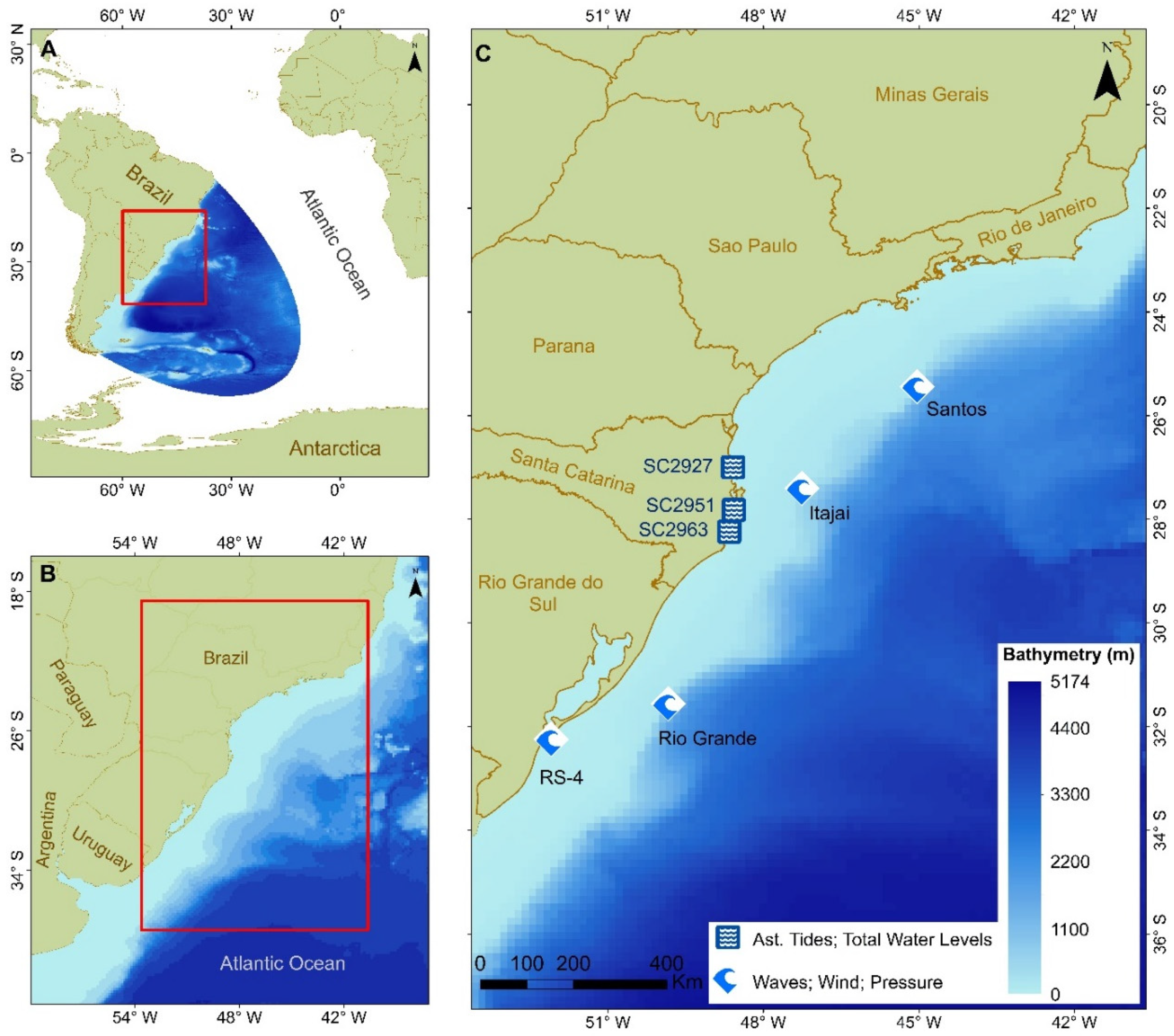
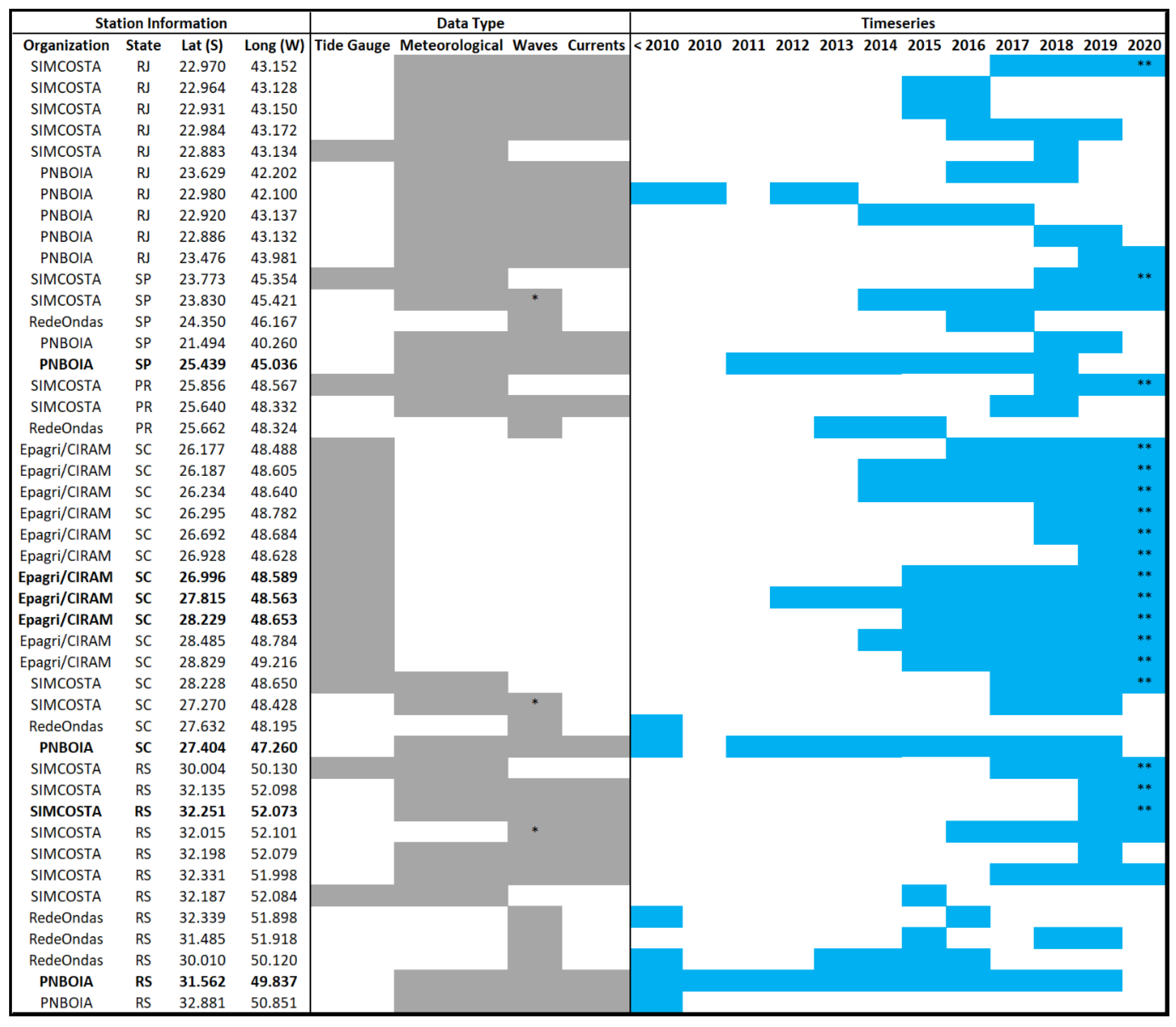
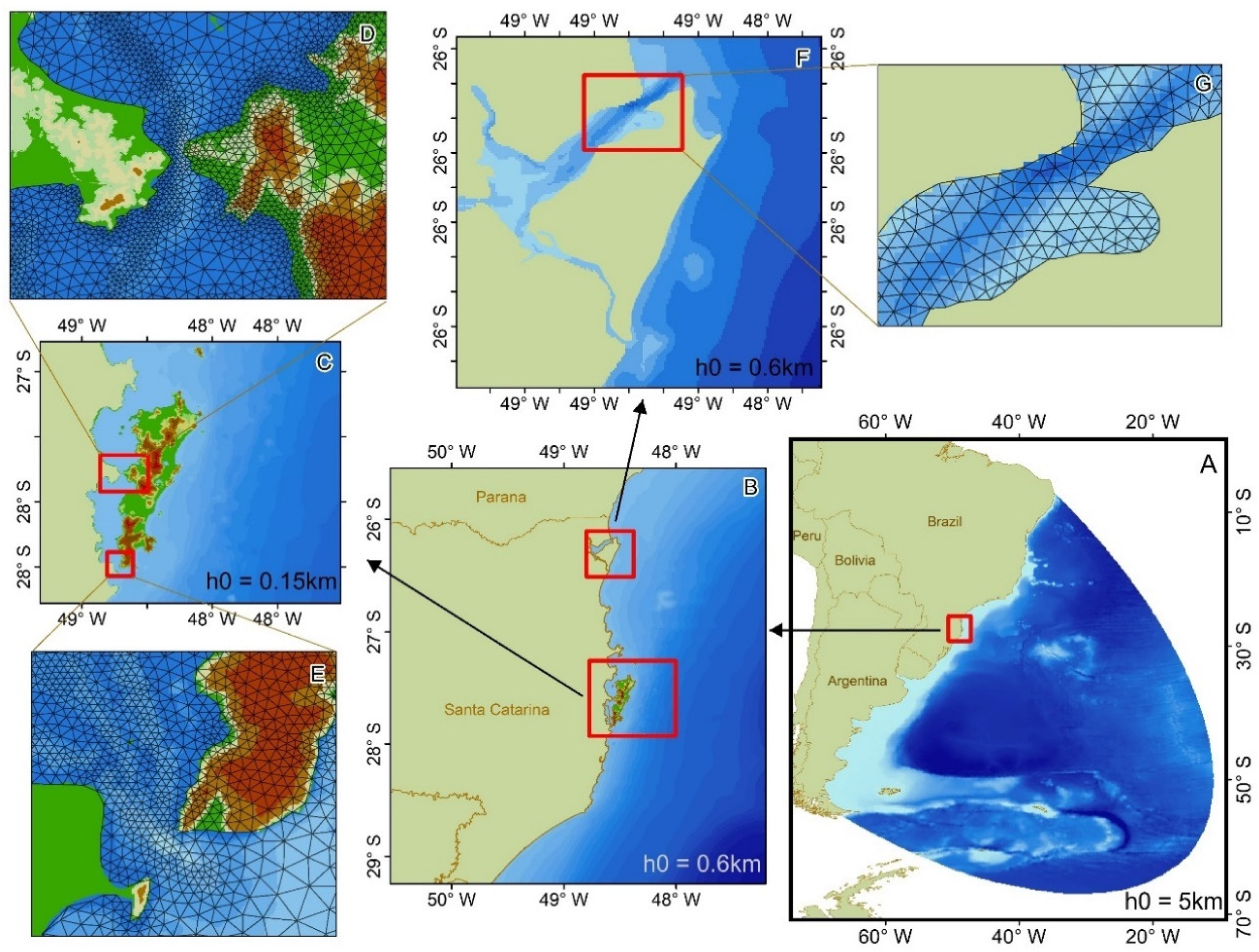
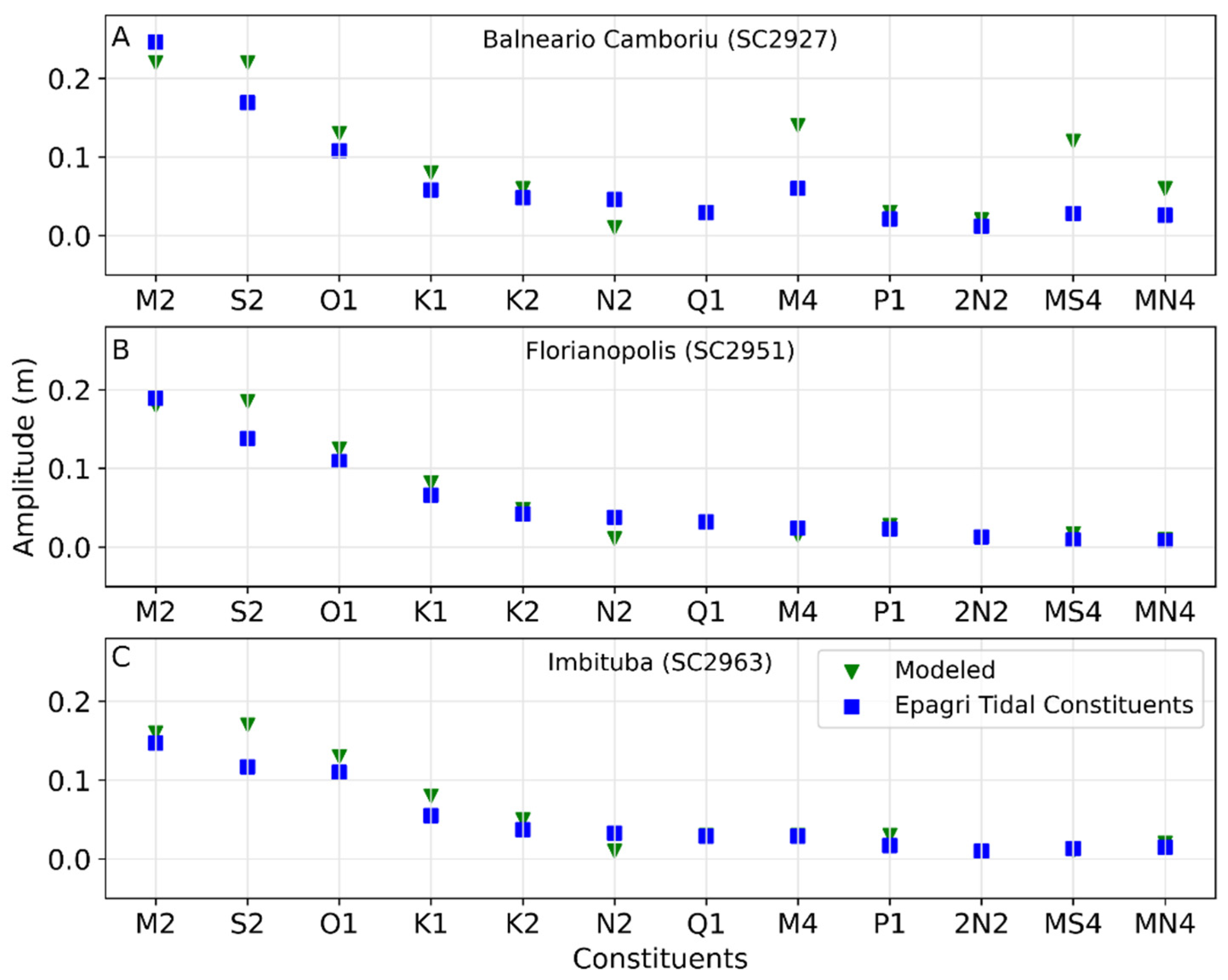

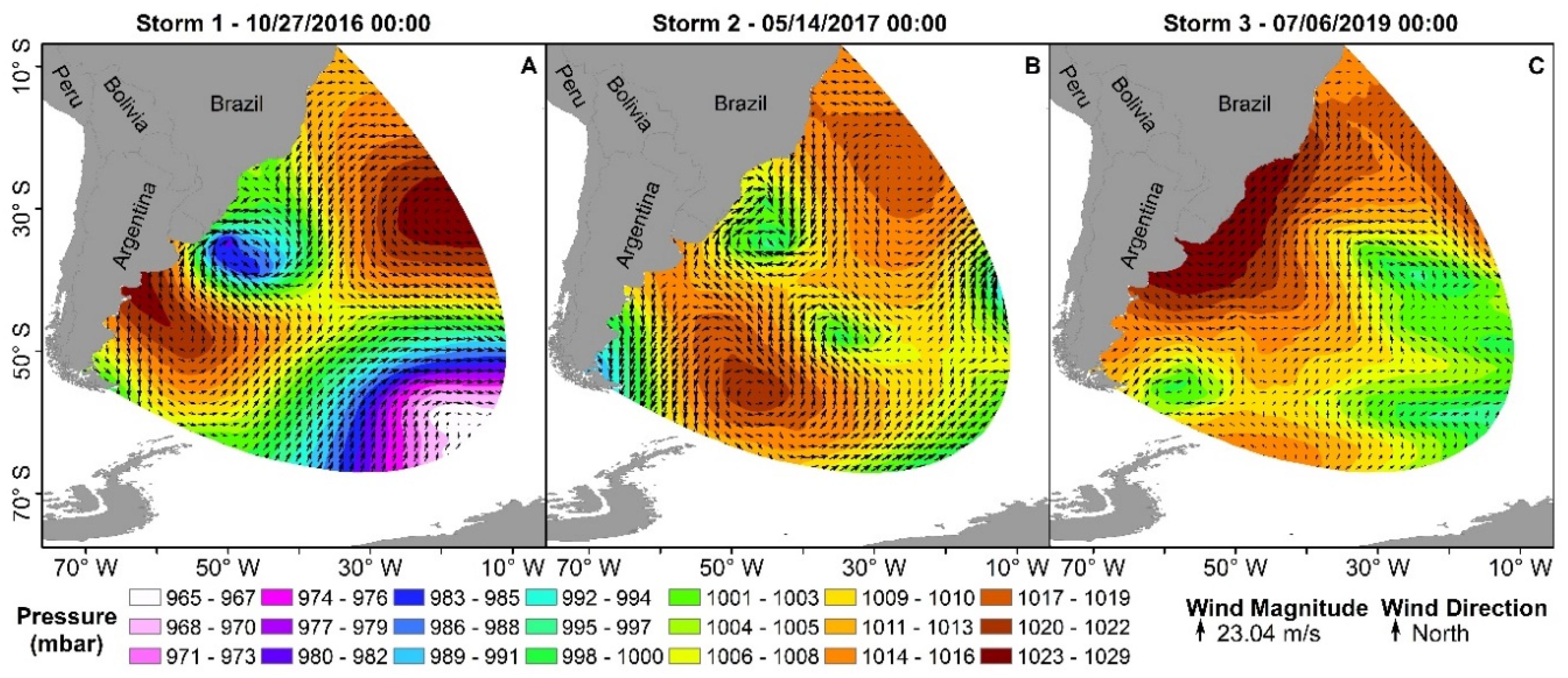
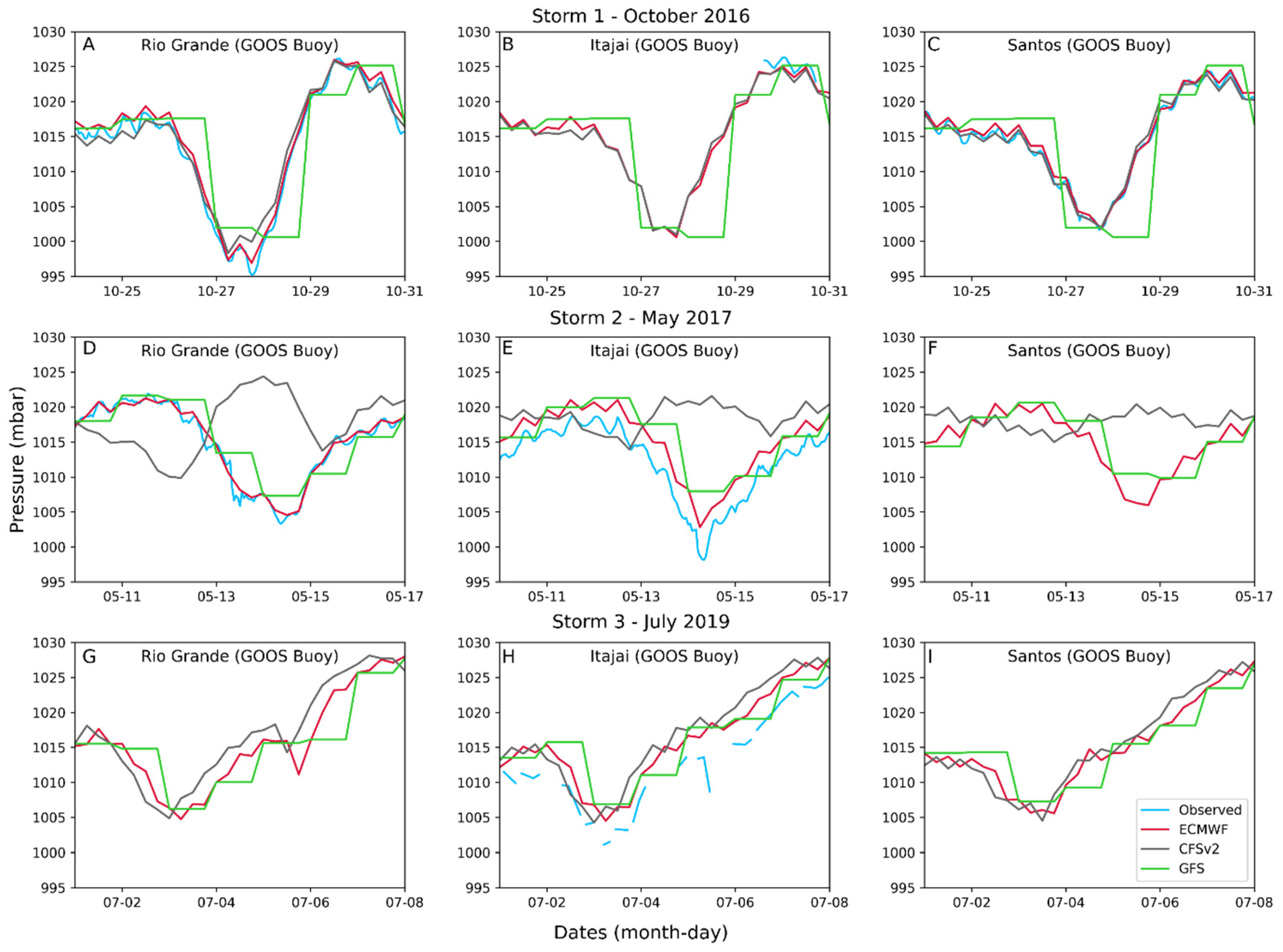
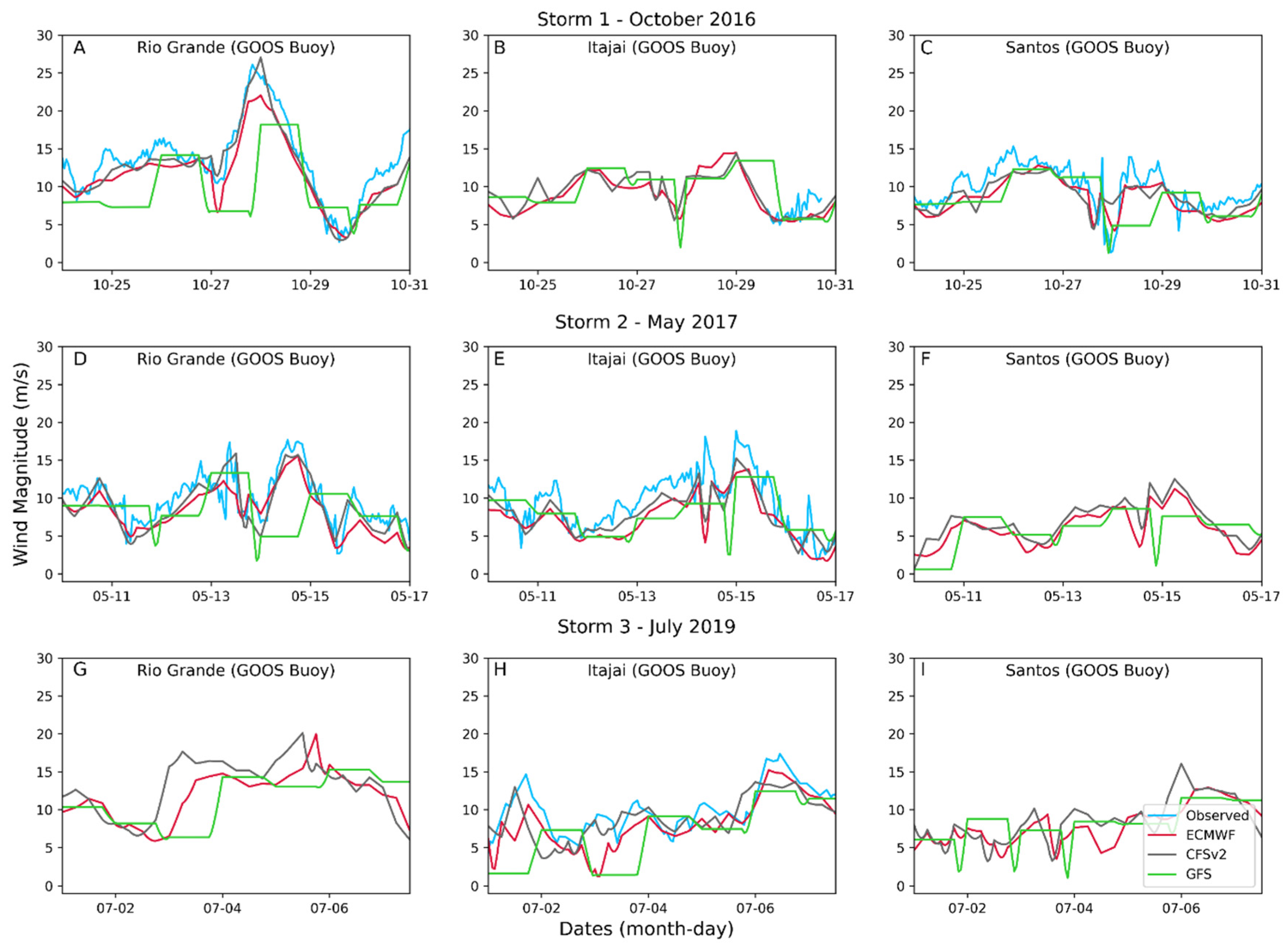
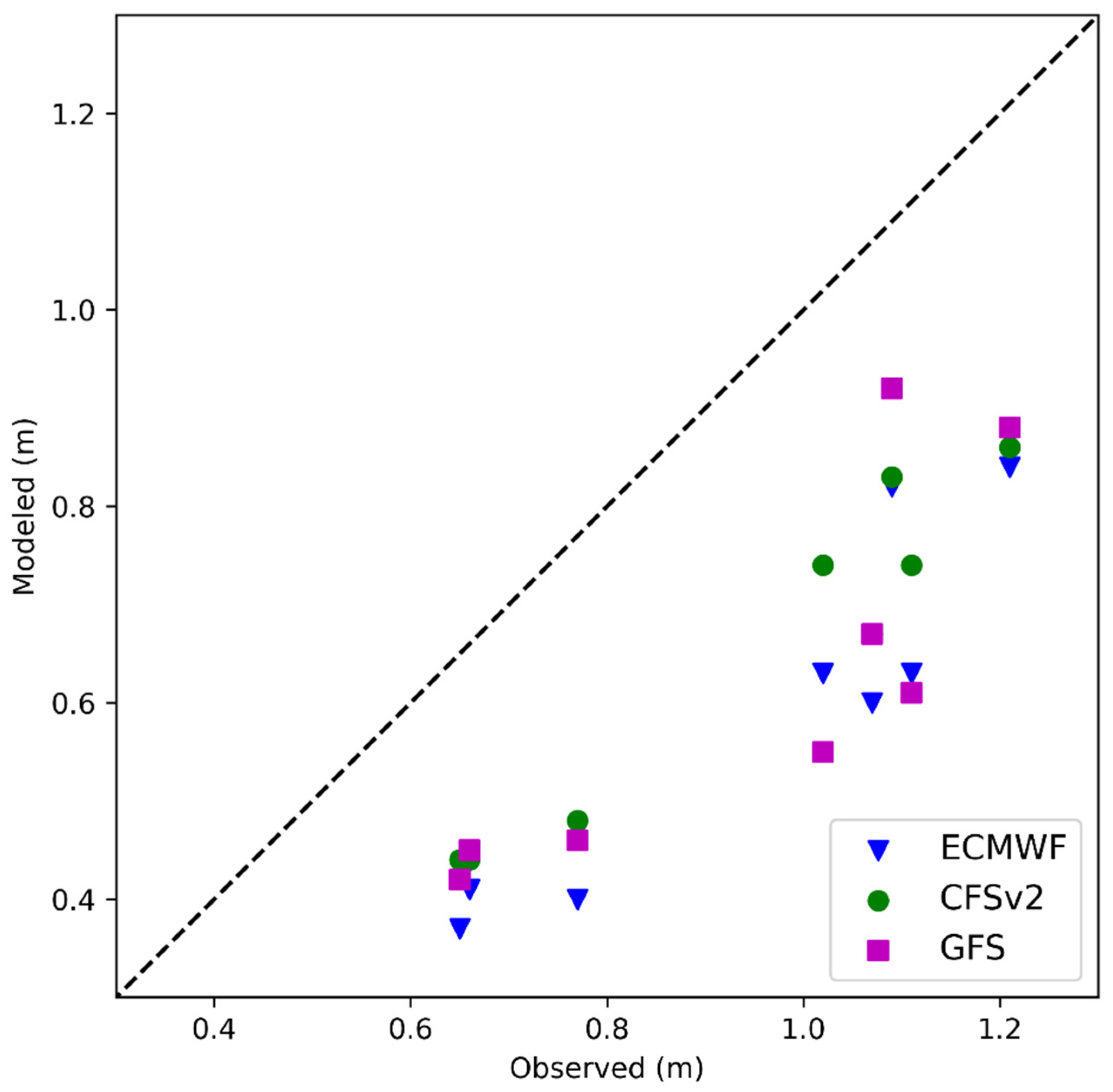
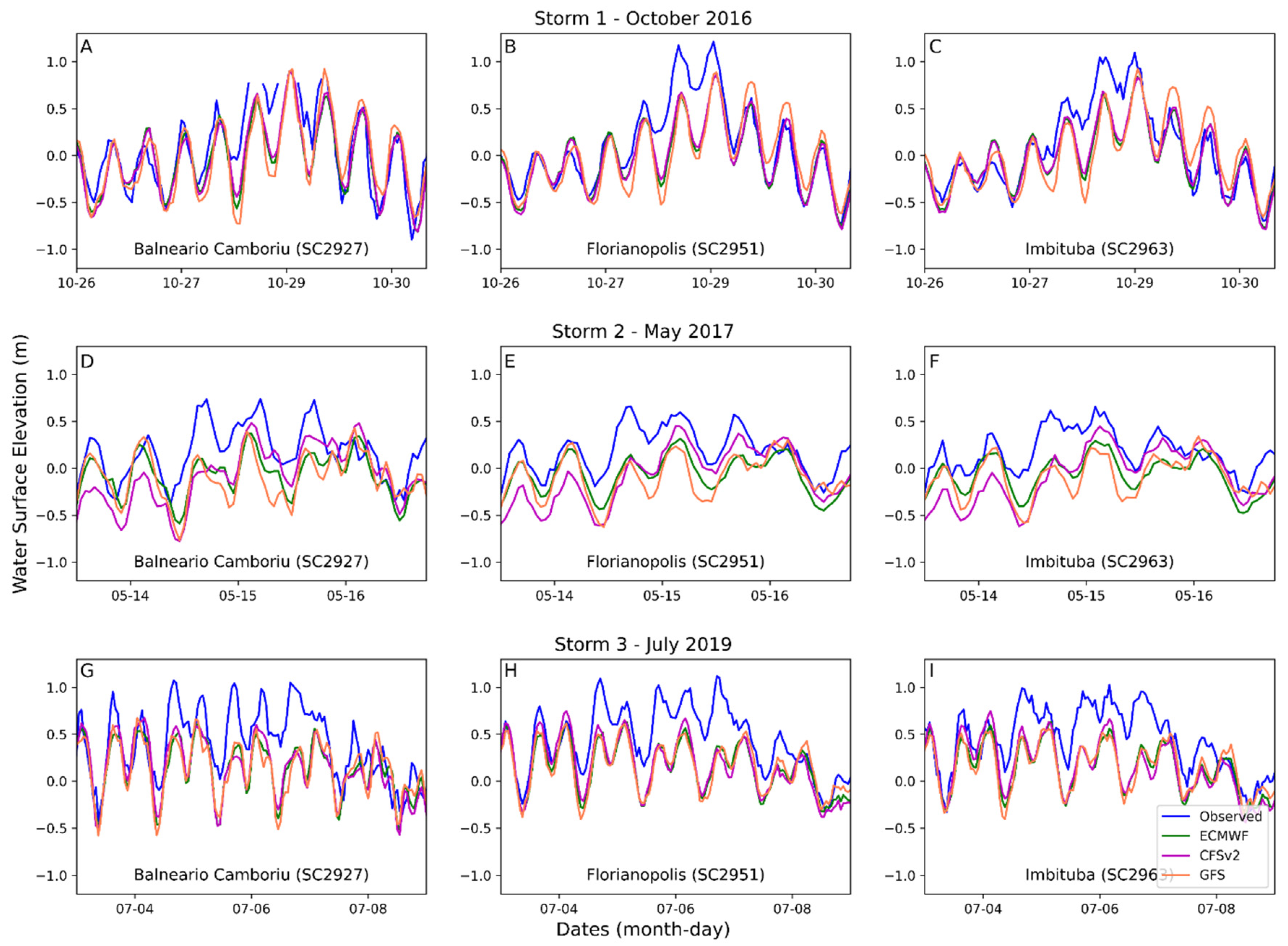
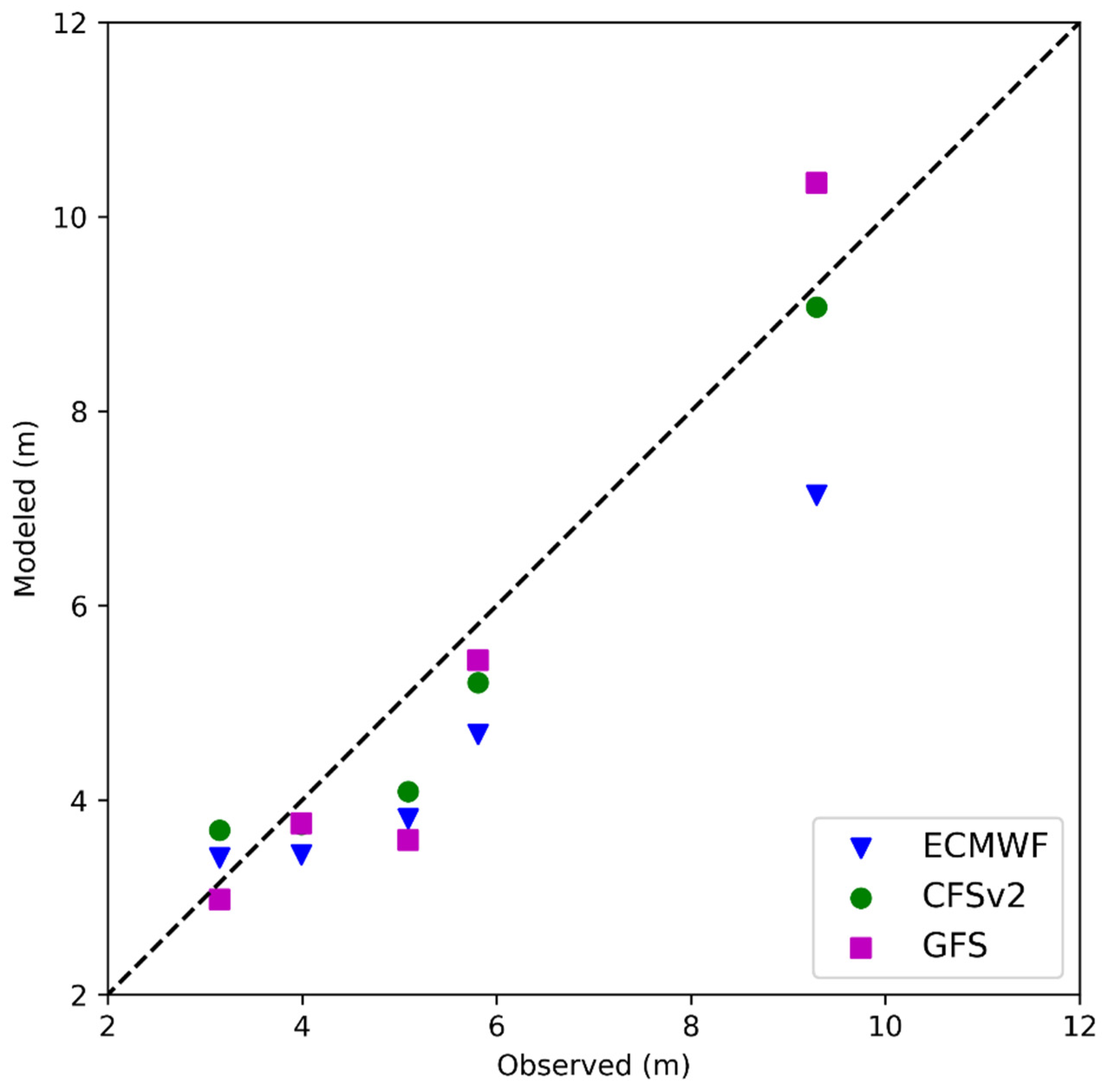
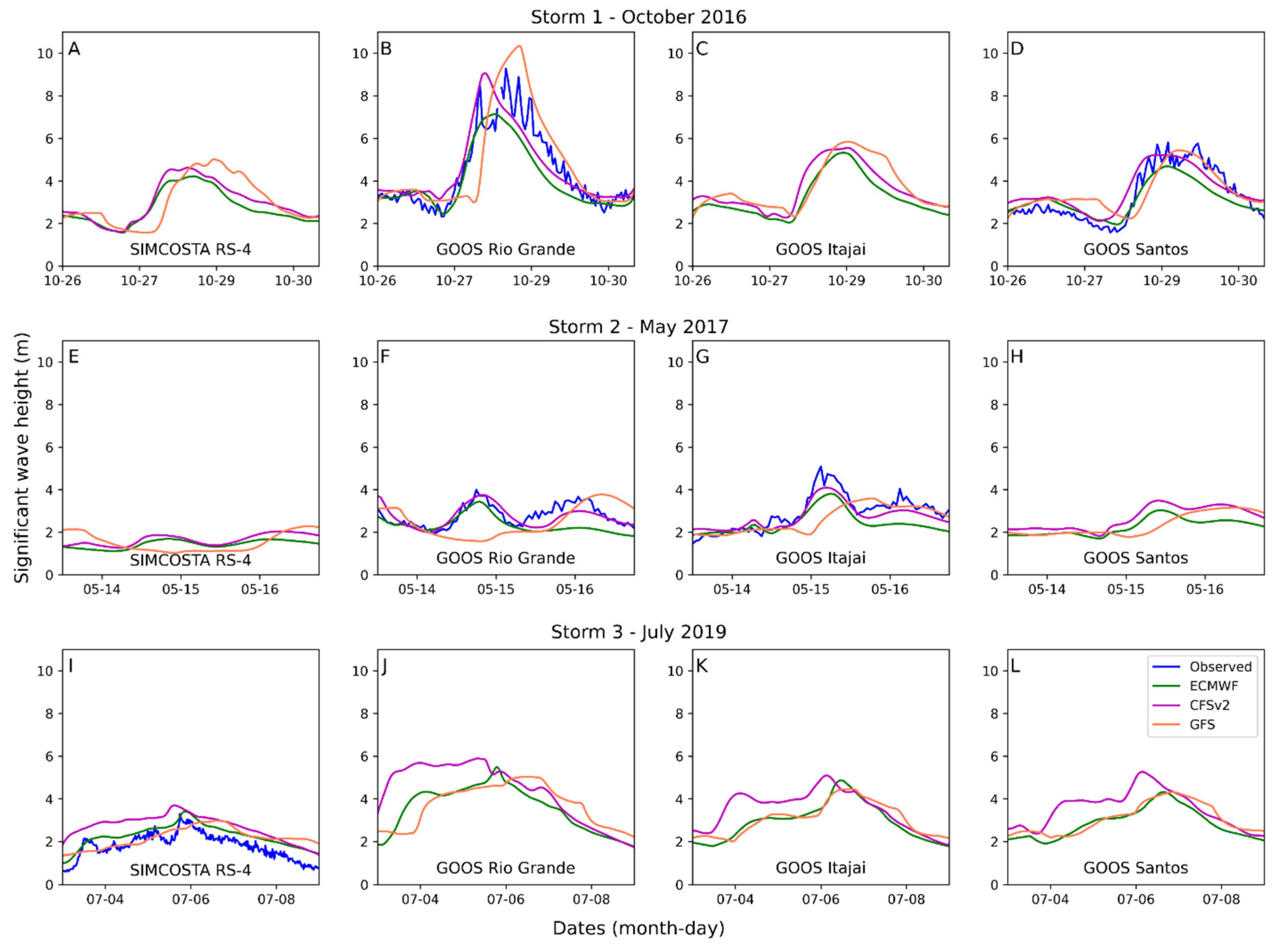
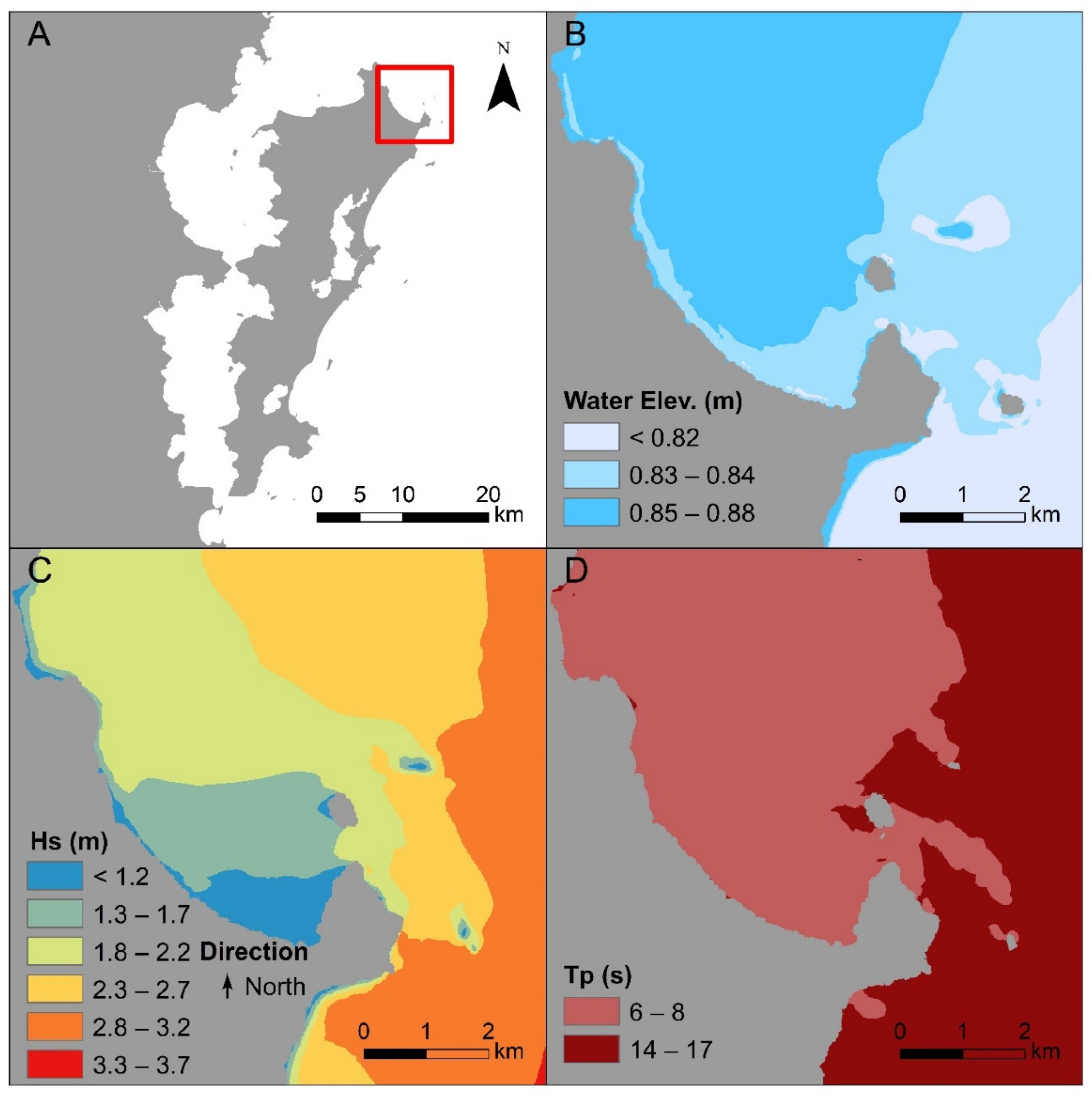
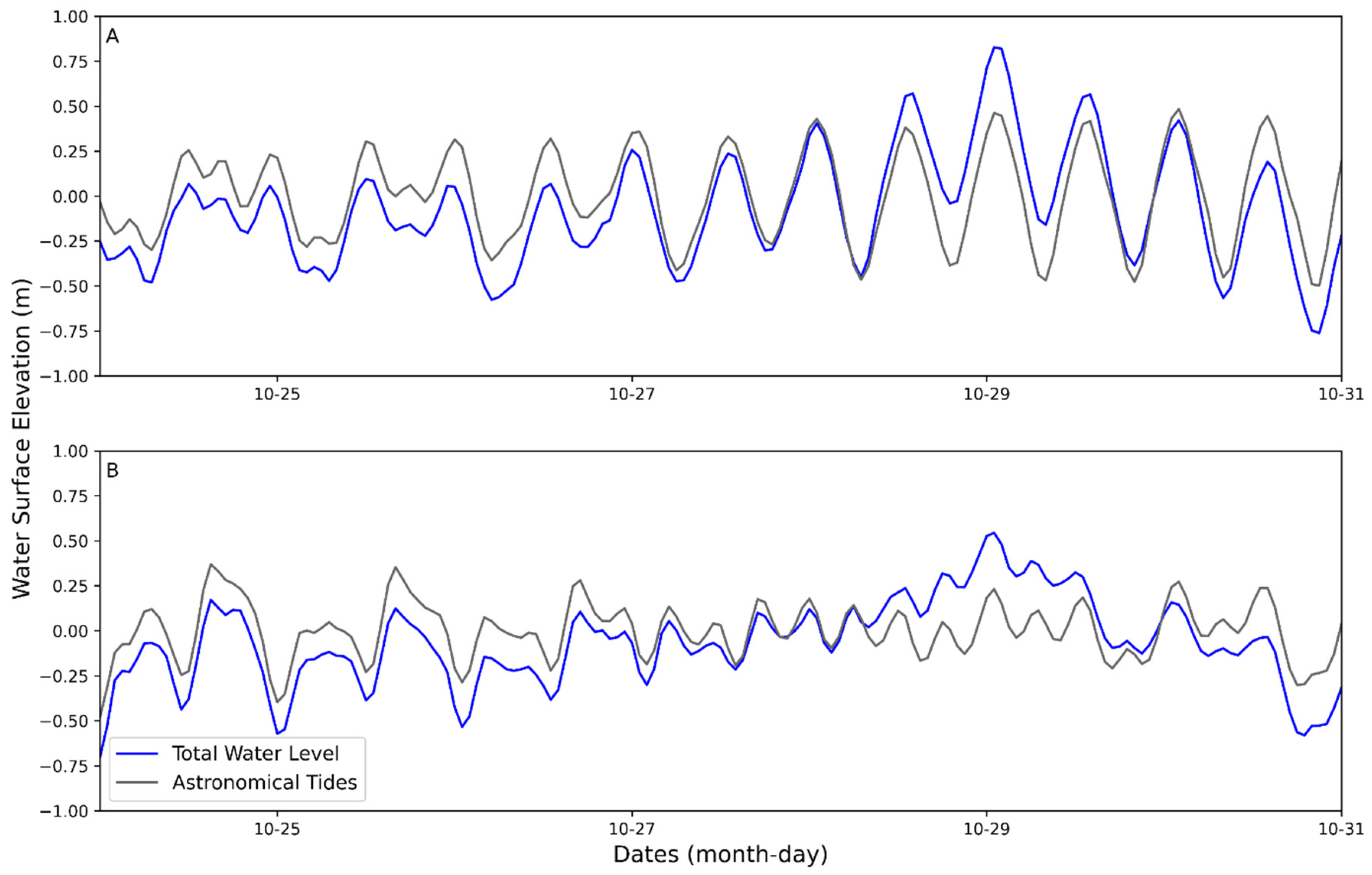
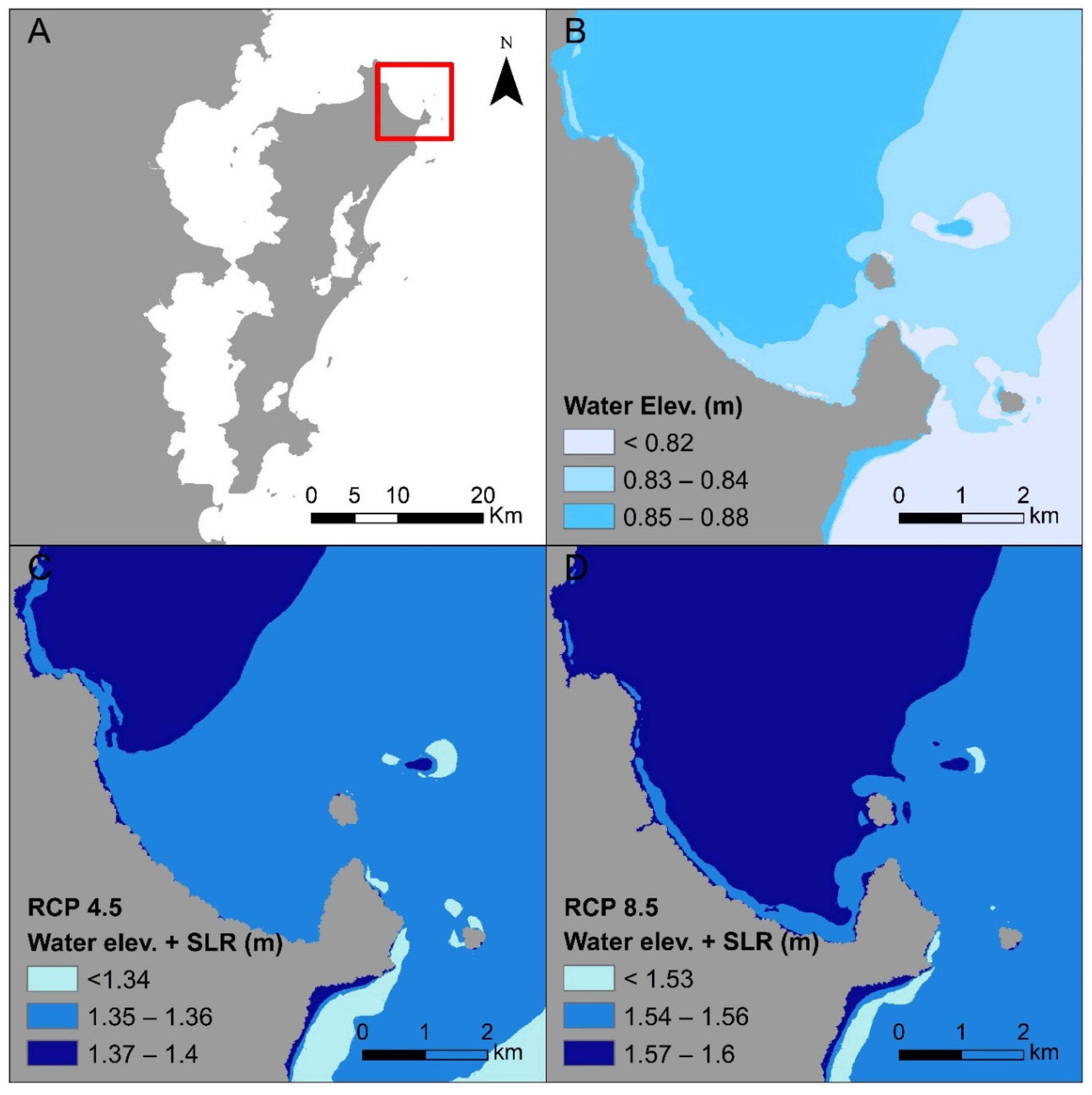
| Storm | Station | CFSv2 | ERA 5 | GFS |
|---|---|---|---|---|
| Storm 1 | Balneario Camboriu | 0.24 | 0.25 | 0.29 |
| Florianopolis | 0.20 | 0.21 | 0.25 | |
| Imbituba | 0.19 | 0.21 | 0.25 | |
| Storm 2 | Balneario Camboriu | 0.34 | 0.26 | 0.30 |
| Florianopolis | 0.32 | 0.22 | 0.26 | |
| Imbituba | 0.32 | 0.23 | 0.27 | |
| Storm 3 | Balneario Camboriu | 0.32 | 0.32 | 0.36 |
| Florianopolis | 0.31 | 0.32 | 0.35 | |
| Imbituba | 0.37 | 0.38 | 0.41 |
| Storm | Station | CFSv2 | ERA 5 | GFS |
|---|---|---|---|---|
| Storm 1 | Balneario Camboriu | 0.17 | 0.18 | 0.22 |
| Florianopolis | 0.18 | 0.20 | 0.23 | |
| Imbituba | 0.17 | 0.20 | 0.23 | |
| Storm 2 | Balneario Camboriu | 0.27 | 0.20 | 0.23 |
| Florianopolis | 0.31 | 0.21 | 0.25 | |
| Imbituba | 0.32 | 0.22 | 0.26 | |
| Storm 3 | Balneario Camboriu | 0.28 | 0.28 | 0.31 |
| Florianopolis | 0.31 | 0.31 | 0.33 | |
| Imbituba | 0.33 | 0.33 | 0.35 |
| Storm | Station | CFSv2 | Delay | ERA 5 | Delay | GFS | Delay | Observed | Date Time |
|---|---|---|---|---|---|---|---|---|---|
| Storm 1 | Rio Grande | 9.07 | −10 h | 7.14 | −7 h | 10.35 | +6 h | 9.29 | 2016-10-28 12:00 |
| Santos | 5.21 | −2 h | 4.68 | 0 h | 5.44 | +5 h | 5.81 | 2016-10-29 03:00 | |
| Storm 2 | Rio Grande | 3.75 | +2 h | 3.44 | +1 h | 3.76 | +14 h | 3.99 | 2017-05-14 18:00 |
| Itajai | 4.09 | +2 h | 3.81 | +3 h | 3.59 | +15 h | 5.09 | 2017-05-15 03:00 | |
| Storm 3 | RS-4 | 3.69 | −3 h | 3.41 | +3 h | 2.98 | −4 h | 3.15 | 2019-07-05 18:00 |
| Storm | Station | CFSv2 | ERA 5 | GFS |
|---|---|---|---|---|
| Storm 1 | Rio Grande | 0.71 | 0.732 | 0.951 |
| Santos | 0.562 | 0.617 | 0.636 | |
| Storm 2 | Rio Grande | 0.424 | 0.488 | 0.706 |
| Itajai | 0.38 | 0.53 | 0.7 | |
| Storm 3 | RS-4 | 0.766 | 0.433 | 0.615 |
Publisher’s Note: MDPI stays neutral with regard to jurisdictional claims in published maps and institutional affiliations. |
© 2020 by the authors. Licensee MDPI, Basel, Switzerland. This article is an open access article distributed under the terms and conditions of the Creative Commons Attribution (CC BY) license (http://creativecommons.org/licenses/by/4.0/).
Share and Cite
de Lima, A.d.S.; Khalid, A.; Miesse, T.W.; Cassalho, F.; Ferreira, C.; Scherer, M.E.G.; Bonetti, J. Hydrodynamic and Waves Response during Storm Surges on the Southern Brazilian Coast: A Hindcast Study. Water 2020, 12, 3538. https://doi.org/10.3390/w12123538
de Lima AdS, Khalid A, Miesse TW, Cassalho F, Ferreira C, Scherer MEG, Bonetti J. Hydrodynamic and Waves Response during Storm Surges on the Southern Brazilian Coast: A Hindcast Study. Water. 2020; 12(12):3538. https://doi.org/10.3390/w12123538
Chicago/Turabian Stylede Lima, Andre de Souza, Arslaan Khalid, Tyler Will Miesse, Felicio Cassalho, Celso Ferreira, Marinez Eymael Garcia Scherer, and Jarbas Bonetti. 2020. "Hydrodynamic and Waves Response during Storm Surges on the Southern Brazilian Coast: A Hindcast Study" Water 12, no. 12: 3538. https://doi.org/10.3390/w12123538
APA Stylede Lima, A. d. S., Khalid, A., Miesse, T. W., Cassalho, F., Ferreira, C., Scherer, M. E. G., & Bonetti, J. (2020). Hydrodynamic and Waves Response during Storm Surges on the Southern Brazilian Coast: A Hindcast Study. Water, 12(12), 3538. https://doi.org/10.3390/w12123538






